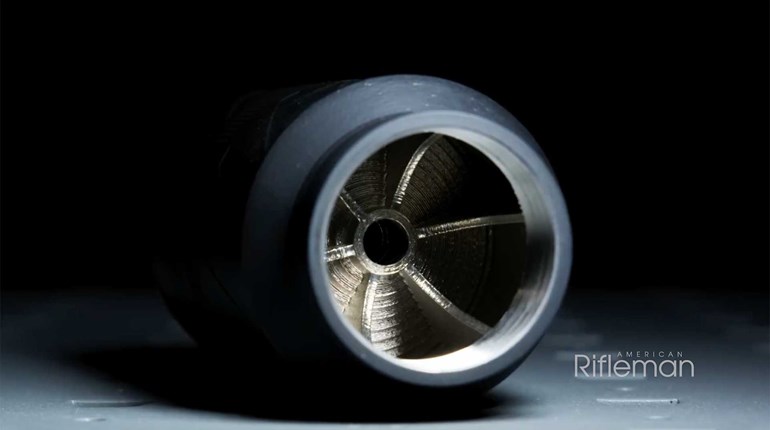
A million years ago, when the earth first cooled and dinosaurs roamed the earth, the intermediate-caliber, semi-automatic rifle landscape looked a lot different than it does today. An AK-47-pattern rifle would set you back maybe $350, while even the cheapest AR-15-style rifle was somewhere between $750 and $900. Don’t tell me about the old ways. I was there. Recently, though, it has flipped: a glut of AR-15s combined with decreasing AK imports means that an AK-47-pattern rifle will set you back nearly a grand, while ARs could be found for about $500 (well, before 2020, at least).
At that price point, you can expect an entry-level AR to have pretty much general mil-spec components, a trigger that can only charitably be called “gritty,” delta-ring-style handguard and A2-style front sight. Notice the lack of “freefloat” or “lightweight” anywhere in that description.
Now, however, that paradigm has a challenger. American Tactical’s Alpha-15 offers a 5.5-pound rifle with a freefloat handguard and flip-up sights for $499. Inconceivable! It’s an outgrowth of the Omni polymer-receiver system the company has offered for nearly a decade, with both the upper and lower receivers constructed of polymer.
I know, I know. Polymer AR-15 receivers have had, well, a less-than-stellar reception over the years. Part of it stems from a time when ARs were more expensive, and the polymer craze was one way to lower costs. Obviously, this meant that the polymer lowers were geared toward the entry-level end of the spectrum, which meant that fit and finish were less important in the design parameters than coming in at a price point. This led to issues both great and small, with pins that didn’t fit quite right on the small end and buffer-tube extension failures on the great end. Our Rifles editor reviewed a handful of polymer lowers in our March 2015 issue and came away unimpressed—while the polymer lowers had certain advantages, he wasn’t convinced it overcame some significant disadvantages.

One of the major areas in the lower receiver that he pointed out as needing reinforcement was the buffer-tube extension, specifically where it screws into the lower receiver. American Tactical has addressed this with the addition of carbon fiber infused into the polymer at the receiver extension. The end result is a solid, tight connection that held up at least as well as a traditional, aluminum receiver in our testing. One thing of note, though: the castle nut securing the extension to the receiver was not staked. While this isn’t a deal-breaker, it’s something that should either be addressed or at least periodically checked.
On the upper receiver, American Tactical has beefed up the areas where problems could potentially occur, notably the tabs for the takedown pins as well as the barrel insert and barrel-nut threads.
On the upper receiver, American Tactical has beefed up the areas where problems could potentially occur, notably the tabs for the takedown pins as well as the barrel insert and barrel-nut threads. Pretty much any surface that might see any significant pressure is reinforced with metal, resulting in an upper receiver that American Tactical claims maintains the durability of an aluminum receiver with lower weight. While we didn’t subject the Alpha-15 to a 5,000-round torture test (oh, for the days when we had ammo for such endeavors … ), it held up fine in our testing.
There are some areas of nit-picking, however. The lower receiver seemed, well, not quite finished; some of the plastic flashing remained on the seams. This is mostly an aesthetic issue, but should be addressed before significant range time. Certain other polymer firearms have had similar issues that, left unattended, could prove painful under recoil. A few seconds with some ultra-fine sandpaper will remedy this—just be careful not to sand too much.

Next, though, is more than mere looks. A good number of the lower-receiver parts are polymer, which again could prove to be a false cost and/or weight savings down the road. Again, in our testing the parts functioned as intended and held up admirably over several hundred rounds, but I’d be wary of the stress put upon, say, the bolt catch over time. If you tinker with your AR and have the tools, replacing these pieces is both simple and inexpensive—and you’re likely to swap out at least some of these parts anyway as you make the carbine your own. It’s one of the big appeals of the AR-15. I have quite a few ARs, and I think maybe one or two, tops, have all the original components with which they left the factory.
And, if I may be indulged a minor quibble, while the Alpha-15 does ship with flip-up sights, they are not exactly the most robust versions out there. Sure, they’re better than nothing, and considering that the vast majority of the group most likely to buy an AR like the Alpha-15 are going to put a red-dot sight on it anyway, they’re fine as a backup, but it may take a little elbow grease and fiddling to get things just right. You might want to consider upgrading the sights to something like Magpul’s MBUS, but you certainly don’t have to as the supplied units do work.
Realistically, though, the market group for the Alpha-15 is going to be either the novice AR-15 owner, in which case they’ll likely leave it in a safe and fire 50 rounds per year, or the tinkerer, who’s going to replace the majority of the small parts to suit their needs anyway. It’s a lot like why American Tactical ships the Alpha-15 with the standard, mil-spec collapsible stock and pistol grip—the end user is most likely going to swap them out in short order (sometimes even minutes) after getting the rifle.

Another area where the Alpha-15 would be a great choice would be for a .22 LR conversion using a kit like the CMMG Bravo. Pull the 5.56 NATO bolt-carrier group, insert the .22 LR bolt carrier, and get ready for hours of inexpensive rimfire training, new-shooter introduction to the AR-15 or simply fun plinking. Again, the beauty of the Alpha-15 is that $499 retail price—that’s essentially the same price as a dedicated .22 LR AR-15-style rifle, but with the added benefit of being readily interchangeable with 5.56 NATO.
Here’s another consideration: while, say, four or five years ago that $499 price was commensurate with many other entry-level rifles, the times, as the song goes, are a-changing. A quick glance at the current state of the market reveals that “name-brand” ARs are commanding well north of $1,000 these days. Even “bargain” ARs are seeing prices closer to $700 or $800. While, yes, these prices are continually evolving, taking a current snapshot (as I write this; who knows what the market may look like once this article goes to print), shows the Alpha-15 to be quite affordable indeed compared to other options on the market.
Even if you were to upgrade the lower receiver parts, a number of companies make excellent drop-in triggers for around $100. Pick and choose your favorite upgrades for magazine releases, safety selectors and even bolt releases, and you’re still not talking a ton of money. Replace the stock and pistol grip with whatever you like, and chances are you’ll wind up with a rifle setup just the way you like it, still at a decent savings.
One more thing, and this is a pretty big one: The Alpha-15 tips the scales at a scant 5.5 pounds. That’s light—most standard AR-15s come in nearly a pound heavier. A few years ago, I built a super-lightweight AR that came in a hair less than 5 pounds with the optic, and cost slightly more than $1,500. While, yes, some things have changed in that time, I don’t think the bottom line would be significantly different were I to replicate that build today, and that yielded a rifle only 10 ounces or so lighter than this off-the-shelf Alpha-15. If you were looking for a lightweight rifle at a great price, well, here’s one to consider.
In testing the Alpha-15, we opted for two full-metal-jacket projectiles—in standard 55- and 62-grain weight—and one heavier round more suited for long-range accuracy. It’s a pretty safe bet no one’s going to be picking up a $500, 16-inch-barrel AR to bring to Camp Perry, and the most likely choice of ammo for this rifle is going to be “whatever’s cheapest at the moment.” The 73-grain Hornady match ammo proved to be slightly problematic, as it appeared the polymer tip would (infrequently) catch on the chamber, resulting in a small handful of failures that needed clearing. Whether it was the polymer tip or the slightly longer overall cartridge length is a valid question, however it was only observed three times, and the full-metal-jacket rounds all fed and fired without incident. If we’re honest, inexpensive FMJ ammunition is really all this rifle is likely to ever see in use.
Also worth mentioning is that some of the newer metal magazines fit tighter in the magazine well than older metal magazines or polymer variants. I noticed it especially with the superlative SureFeed magazines from Okay Industries, where the magazines would not drop free from the magazine and required a bit of assistance from the support hand to remove empty mags. Polymer magazines, including Magpul PMags, Mission First Tactical polymer magazines and the included American Tactical versions all worked without incident. I’m hesitant to draw any conclusion on the reason for this, except to reiterate the excellent suggestion to test everything well in advance so you know what magazines your semi-automatic firearm prefers. This, of course, is always a good idea, naturally.
 Accuracy was certainly decent, with no groups either outlandishly small or large. As the Shooting Results indicate, average group size hovered around 2 MOA, which the jaded AR enthusiast of 2022 might scoff at, but in the grand scheme of AR accuracy represents a pretty precise rifle for a lightweight, low-cost option. It’s a fairly recent phenomenon that all AR-15-style rifles be expected to shoot sub-MOA, and not all that long ago, even a bolt-action rifle that provided 1- to 2-MOA groups would have been lauded. For a budget rifle with a pencil barrel geared more toward weight savings than ultimate accuracy, the Alpha-15 held its own just fine.
Accuracy was certainly decent, with no groups either outlandishly small or large. As the Shooting Results indicate, average group size hovered around 2 MOA, which the jaded AR enthusiast of 2022 might scoff at, but in the grand scheme of AR accuracy represents a pretty precise rifle for a lightweight, low-cost option. It’s a fairly recent phenomenon that all AR-15-style rifles be expected to shoot sub-MOA, and not all that long ago, even a bolt-action rifle that provided 1- to 2-MOA groups would have been lauded. For a budget rifle with a pencil barrel geared more toward weight savings than ultimate accuracy, the Alpha-15 held its own just fine.
Whether you’re considering your first AR-15, looking for something to tinker with or want to lighten the load a bit, American Tactical’s Alpha-15 is worth your consideration. Lightweight and well-equipped, it raises the bar on what should constitute entry-level—and might even make you re-think what you should expect in an entry-level carbine.
Is the Alpha-15 perfect? Hardly. There are some areas, like the polymer lower components, that concern me over time and should probably be replaced if the rifle is to see a lot of use. Again, though, as a platform upon which to tinker and upgrade, it’s a great starting point. It’s lightweight and affordable, so it can check boxes for those who might not otherwise have a modern sporting rifle. In the case of the Alpha-15, the good more than outweighs the not-so-good, and that’s a good thing.



































